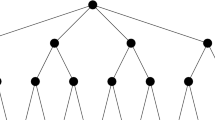Abstract
In this paper, we develop optimal trading strategies for the risk averse investor by minimizing the expected cost and the risk of execution. We present quadratic programming formulation that includes stochastic dominance constraints to render the preference relationship attitude of both risk neutral and risk averse investors. We also present a cutting plane approach to facilitate computational advantage in solving it. The efficacy of the algorithm is shown with the help of numerical examples.




Similar content being viewed by others
Notes
Considering tick-based movements at most exchanges, it is a reasonable assumption that the probability distributions of the cost variables in trade executions will almost always be finite discrete distributions.
For all simulation purposes in this paper, we have taken \(Z_k\)’s to be i.i.d. gamma random variables, with mean \(\mu _Z\) and variance \(\sigma _Z^2\).
In the reference of this paper, standard QPP approach refers to the QPP formulation, i.e. QPP without the FSD-constraints, given in (Khemchandani et al. 2012).
This cut belongs to the set \(J_{1}=1\), added to make the objective function finite.
Data downloaded from Yahoo! Finance website for the period of Mar’11–Apr’11.
References
Almgren, R., & Chriss, N. (2000). Optimal execution of portfolio transactions. Journal of Risk, 3, 5–39.
Almgren, R. (2003). Optimal execution with nonlinear impact functions and trading-enhanced risk. Applied Mathematical Finance, 1, 1–18.
Bertsimas, D., & Lo, A. (1998). Optimal control of execution costs. Journal of Financial Markets, 1, 1–50.
Bertsimas, D., Lo, A. W., & Hummel, P. (1999). Optimal control of execution costs for portfolios. Computing in Science and Engineering, 1(6), 40–53.
Dentcheva, D., & Ruszczyński, A. (2006). Portfolio optimization with stochastic dominance. Journal of Banking and Finance, 30, 433–451.
Fábián, C., Mitra, G., & Roman, D. (2011). Processing second-order stochastic dominance models using cutting-plane representations. Mathematical Programming, 130, 33–57.
Fábián, C., Mitra, G., Roman, D., & Zverovich, V. (2011a). An enhanced model for portfolio choice with SSD criteria: Constructive approach. Quantitative Finance, 11(10), 1525–1534.
Fishburn, P. C. (1964). Decision and value theory. New York: Wiley.
Huberman, G., & Stanzl, W. (2005). Optimal liquidity trading. Review of Finance, 9, 165–200.
Khemchandani, R., Gupta, N., Chaudhary, A., & Chandra, S. (2012). Optimal execution with weighted impact functions: A quadratic programming approach. Optimization Letters, 21, 1–18.
Kissell, R., & Malamut, R. (2006). Algorithmic decision-making framework. Journal of Trading, 1, 12–21.
Mangasarian, O. L. (1994). Nonlinear programming. Philadelphia, PA: SIAM.
Perold, A. F. (1998). The implementation shortfall: Paper versus reality. Journal of Portfolio Management, 14, 4–9.
Roman, D., Darby-Dowman, K., & Mitra, G. (2006). Portfolio construction based on stochastic dominance and target return distributions. Mathematical Programming, 108, 541–569.
Roman, D., Mitra, G., & Darby-Dowman, K. (2007). Mean-risk models using two risk measures: A multi-objective approach. Quantitative Finance, 7, 443–458.
Sriboonchitta, S., Wong, W. K., Dhompongsa, S., & Nguyen, H. T. (2010). Stochastic dominance and applications to finance, risk and economics. Chapman and Hall. ISBN 978-1-4200-8266-1.
Whitmore, G. A., & Findlay, M. C. (1978). Stochastic dominance: An approach to decision-making under risk. Lexington, MA: D.C. Heath.
Author information
Authors and Affiliations
Corresponding author
Rights and permissions
About this article
Cite this article
Khemchandani, R., Bhardwaj, A. & Chandra, S. Single asset optimal trading strategies with stochastic dominance constraints. Ann Oper Res 243, 211–228 (2016). https://doi.org/10.1007/s10479-014-1697-0
Published:
Issue Date:
DOI: https://doi.org/10.1007/s10479-014-1697-0




